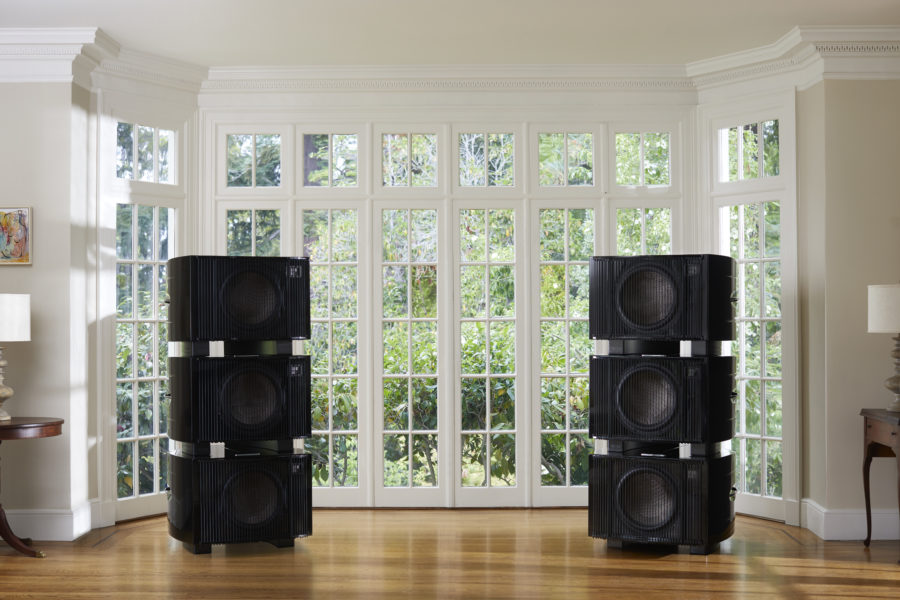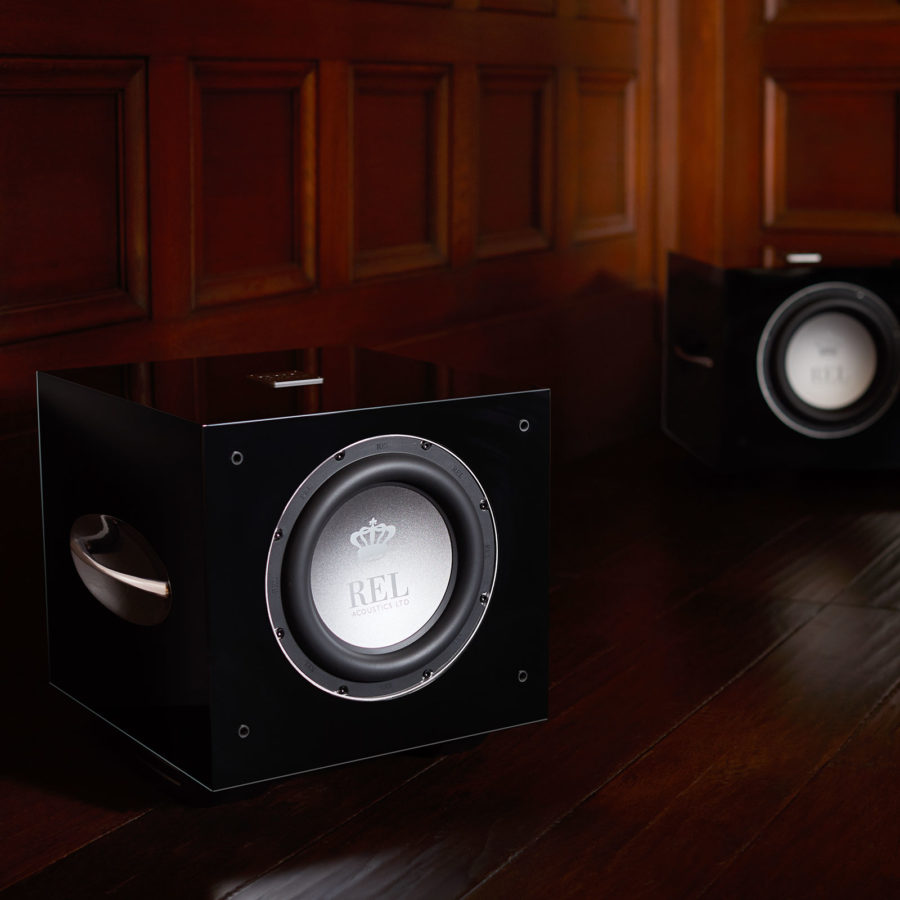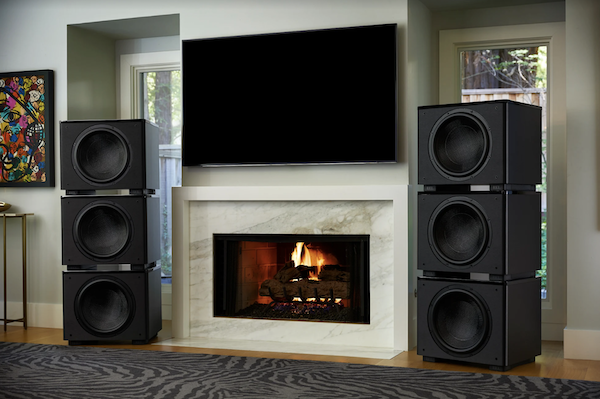Blog
Getting It Right
Why REL Only Uses 3 (or in rare cases 5) units to Achieve Sonic Perfection
REL Line Arrays are one of the hottest trend in the world of ultra-high-performance home audio. Whether for the highest steps of 2-channel performance or the home theatre, keen enthusiasts have concluded that restoring height to its fullest extent combined with the far more spacious soundstage and rich harmonic structure delivered by REL Line Arrays is impossible to forget, once heard.
Let’s talk Line Arrays—what they are and what they are not. Firstly, REL Line Arrays refer to vertical stacks of either 3—or, in very tall rooms, 5—RELs specifically designed with stacking in mind. Not all RELs can be stacked due to safety concerns; it takes a lot of weight for a line array to be stable. Therefore, stacking 3 lightweight subwoofers on top of each other is unwise. But when stacking our subwoofers designed for Line Arrays, why stack 3 or 5? Why not stack 2 or 4?

3 is the minimum number to deliver the magic of Line Arrays. 5 are needed only for very tall (and large) rooms. We use odd-numbered multiples because, in the case of the far more common 3-stack, it is the minimum needed to deliver the precise combination of (1.) superb deep, foundational bass (the bottom unit, also referred to as the “anchor”), (2.) the fast, pistonic midbass attack necessary to capture the drive and energy of music and film sound, and (3.) the upper bass harmonics that blend seamlessly with the harmonic structure from the main speakers and lofts the entire system’s performance to the stratosphere.
What, then, is wrong with 2 being stacked vertically? Nothing, as long as you’re clear what your objective is—2 subwoofers stacked produces better room drive, but nothing more. It smooths out bass and produces more average power throughout the space, but nothing more. In some cases, this can be a good problem solver. However, line arrays are about producing the kind of sonic astonishment found in the upper reaches of this pursuit. Once heard, this type of sound cannot be unheard. If you can afford it, you won’t be able to settle for anything less after you have experienced it.
I verified this recently in my new listening room, which is an open floor plan on the main floor that is some 1,500 square feet (150 square meters) and features tall 10 foot (3 meter) ceilings. It was a great experiment. Using a stereo pair of S/510s (perfect for the long-discontinued Martin Logan CLS I use in this system) the sound was exceptionally good, with a decent low end. The 510s pair perfectly with these fast, pure electrostats. Yet, the system was pushed to deliver the kind of effortless quality I require in my systems (remember, I’m driving 15,000 cubic feet of airspace, not including two staircases present on this floor). Adding a second unit stacked atop the bottom “anchor” S/510s produced the drive and effortless quality I was looking for, but lacked finesse and balance. Not to mention, it lacked the kind of super harmonics that a vertical stack of 3 per side offer.

Later that weekend, I stacked a third S/510 on top of each stack, then dialed in the gain and crossover. I was rewarded with the glorious sound of a full “6 Pack,” the casual street name for 6 RELs in a line array, 3 per side. All of a sudden, music took on a palpability, solidity, and realness that was infinitely open with far better high-frequency content as well as the vertical presentation of a live concert. 2 line arrays per side will not deliver that; there is simply no need to use 4 because that makes it harder for each subwoofer to handle the acoustic range. We are not in the business of selling more units just to sell them. We are here to produce remarkable results. We spend our own money as carefully as you do.
Myths:
Myth 1: “6-packs are just for bass freaks.” Contrary to what this myth implies, the bass itself is third on the list of the amazing feats Line Arrays of RELs routinely deliver. For myself, their first strength is the insane full-sized soundstage effects produced by properly dialing in a 6-pack to the right partnering speakers. Second, they restore the full height to sonic events; every recording benefits from this. Third, is the achingly beautiful, delicate filigree of harmonic rightness that totally rebalances the brightness and harshness in most high resolution systems. Instead, the line arrays deliver honest, natural sound all the way out to channel 8. Also the bass is utterly remarkable. You can spend hours and hours revisiting old recordings, discovering just how much better they were than you ever knew.
Myth 2: “Line Arrays are just for the super-rich.” Nothing great is free or cheap, but my experience with Line Arrays leads me to conclude there is nothing else in the entire realm of high-end audio that even attempts to deliver the sonic greatness of a properly dialed-in Line Array. One of the things I love the most is that you can buy a pair at a time. True, a pair of S/510s will set you back $5,500 (around £5,500), but in the context of systems likely to benefit from this expenditure, this is a reasonable expense given the incredible improvements it will produce.
Myth 3: “Line Arrays are just for super-rich guys with big floorstanders.” This is not even close to true. One of my favorite 6-pack demos had a 6-pack of S/510’s partnering with KEF Ref-1s. For those unfamiliar with these sonic stand-mounted gems, they feature a 5” Uni-Q driver for mids and highs with a 6.5” (170mm) midbass driver. On their own, they produced a wide, even soundstage in a 15’ x 20’ room. The sound at that show was magical; we had reviewers staying late into the night marveling at the speed and lightness coupled with the devastatingly fast bottom end. That system did it all—it handled any kind of music you wanted to play with ease. Industry types spent hours playing their best cuts on the system. The total system price was around $30K. There wasn’t another system at the show—even those in the multi-hundred-thousand-dollar range—that could compete with it for its ability to play anything at any volume, at any scale of music and get fabulous results.

Myth 4: “Line Arrays are just for rich hi-fi snobs:” Clearly you’ve never been to Singapore,” says Captain Jack Sparrow in Pirates of the Caribbean. And so it is in the world of ultra-high performance theatre; this brand of sound has never been heard before. Fast, explosive, visceral, and matched to the height of the events on screen. Until you hear a 6-pack of HT/1510s (around $12,000 complete with cables) anchoring a big home theatre, you haven’t lived. Big? Yes. Loud? Can be. It can be pretty much as loud as you want it to be. But there’s so much more to theatre reproduction. It is speed, dialogue intelligibility, and the ability to drive sound to the furthest reaches in the rear of a large home theatre. There is a clarity and resolution to the sound of 6-packs used in theatre that has never previously been experienced in our industry.
Now get out there and experience a well-setup REL Line Array. Then, write us and share your experience. Thanks for reading.
J











